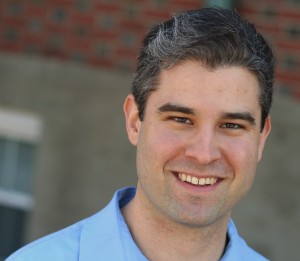Blended Learning, Domestic, Education Quality, K-12, Opinion, Personalized Learning, Required - Written by Wired Academic on Wednesday, November 7, 2012 4:00 - 0 Comments
Michael Horn: Crossfit PE? Blended Learning’s Creative Take On Exercise Class
Physical Activity and Digital Learning: Two Peas in a Pod
By Michael Horn, Columnist
What’s digital learning got to do with physical activity?
Quite a lot I believe.
A couple weekends ago I had the privilege of presenting at TEDx Manhattan Beach where I heard another presenter, Dr. John Ratey, speak about the importance of physical exercise in increasing brain plasticity and boosting student learning. His book, Spark: The Revolutionary New Science of Exercise and the Brain, details the connection.
Although I normally write about digital learning’s potential to transform our education, as a Crossfit enthusiast myself, I believe in the importance of living a healthy life with physical exercise.
One of the biggest misconceptions about the rise of online learning is that a student’s schooling will be spent primarily in front of a computer, with a student clicking away relentlessly as though she were playing eight hours of video games a day.
This couldn’t be further from the truth, however, if the rise of online learning fulfills its potential and creates a truly student-centric education system—which should be the ultimate goal.
As I’ve traveled around the country observing blended-learning schools, the ones I’ve been most struck by are those that give individual students the proper flexibility so that they can have the right experience they need when they need it to boost their success—both in that moment and in life. In the future of education, digital learning should be the platform that facilitates each student having a customized learning experience for her distinct learning needs—whether that experience is online or offline.
Carpe Diem Collegiate Middle and High School, one of my favorite blended-learning models, has no physical education class. Instead the school has what might be described as a fitness center with an on-site trainer who works with each student not on random mandatory athletic units but instead on a tailored program for how to live a healthy life. When students are growing antsy at their desks and need to get some physical exercise to let off some steam and reboot for more learning, they have the autonomy to go to the gym and work out.
The Silicon Valley Flex Academy, which has several elements of what I think the future of schooling will look like, is located across the parking lot from a Crossfit gym. The school has contemplated a formal partnership with the Crossfit affiliate to offer the students a Crossfit for Kids program, which, in my opinion, would be far superior to the gym classes offered at most schools.
My biggest personal surprise in online learning came several years ago when I learned that one of the more popular classes that the Florida Virtual School offers is online physical education. I struggled to imagine what this might mean, but what I ultimately learned is that the class involves a teacher working with each individual student on her daily fitness routine (from running to lifting to playing team sports) to realize her fitness goals and live a healthy life. Recalling my own experience in middle school PE, I could see the immediate benefits of having this sort of an experience instead of an awkward communal one that teaches a student virtually nothing about living a healthy life—and may even discourage that by creating negative associations with physical exercise.
It’s not just physical exercise that should see a healthier balance with the rise of digital learning, but lots of activities. Many schools are increasingly using blended learning to free teachers up to spend more time working with students in project-based learning. I’ve been struck by how much students collaborate with each other naturally—often peer tutoring each other—in the blended-learning schools I’ve visited. Whereas “socialization” often appears to me to be a negative thing in many schools, in blended-learning schools the social interactions appear to me to be far healthier and around helping each student improve. I don’t have hard data on this, but it’s my observation that this is one of the exciting—and often unintended—effects of using a blended-learning model.
To this end, when many people think about full-time virtual schools, one of their biggest fears is about students in their younger years. They ask how could students possibly have a fully online experience when they are so young. What are the downsides of spending so much time in front of a computer? The answer is that in the programs of which I’m aware, most of the learning for students in the younger years is actually offline—with books and manipulatives. The online learning mostly serves as the platform that helps the student’s family communicate with the student’s teacher and individualizes the learning, in addition to providing some exercises and games to build some basic skills.
In an age where the arts, athletics, and other so-called extracurricular activities are increasingly on the chopping block in public schools, digital learning ought to change the equation. Various blended-learning models, for example, should create more flexibility and free up more funds so that schools can offer an array of experiences, including physical exercise.
According to Ratey’s research, that’s something we can’t afford to lose if we’re serious about boosting student achievement. Student-centric digital learning provides a means to make sure that it doesn’t fall by the wayside.
Michael Horn is Executive Director of Education at Innosight Institute, the co-author of “Disrupting Class.” He’s a graduate of Yale University and Harvard Business School. This post first appeared on Forbes.com
Campus Buzz
We welcome Tips & Pitches
Latest WA Original Features
-
Jonathan Mugan: How To Build A Free Computer Within A Computer For Your Child
-
WGU Texas & Three Community Colleges Develop Individual-Paced College Courses
-
Language Learning: Berlin’s Babbel.com Builds Towering Growth Trajectory
-
MOOC Meetup Groups Point To A Blended (Online + Community) Learning Model
-
Education Nation: The Corporatized Charter School In Arizona Called “Carpe Diem”
Paul Glader, Managing Editor
@paulglader
Eleni Glader, Policy Editor
Elbert Chu, Innovation Editor
@elbertchu
Biagio Arobba, Web Developer
@barobba
Ravi Kumar, Reporter & Social Media Editor
@ravinepal
Contributors:
Michael B. Horn, Columnist
@michaelbhorn
Derek Reed
@derekreed
Annie Murphy Paul, Columnist
@AnnieMurphyPaul
Frank Catalano, Columnist
@FrankCatalano
Ryan Craig, Columnist
@UniVenturesFund

The Pulitzer Prize winning investigation newsroom digs into for-profit education.
-
Most Viewed
- Inside Ashford University: A former staffer talks to WiredAcademic
- Pearson Llc + Google Expands LMS Business With "OpenClass" System
- WGU Texas & Three Community Colleges Develop Individual-Paced College Courses
- Pearson Draws Criticism From New York to Texas... Justified? Or Unjustified?
- Guest Column: Why Steve Jobs would have loved digital learning
-
MARKET INTRADAY SNAPSHOT
- Education & Tech Companies We Follow
| APEI | 33.19 |  +0.25 +0.25 |  +0.76% +0.76% | ||
| APOL | 18.75 |  -0.64 -0.64 |  -3.30% -3.30% | ||
| AAPL | 547.06 |  +9.31 +9.31 |  +1.73% +1.73% | ||
| BPI | 8.84 |  -0.21 -0.21 |  -2.32% -2.32% | ||
| CAST | 0.25 |  0.00 0.00 |  +0.00% +0.00% | ||
| CECO | 2.93 |  -0.48 -0.48 |  -14.08% -14.08% | ||
| COCO | 2.25 |  -0.06 -0.06 |  -2.60% -2.60% | ||
| CPLA | 28.66 |  -0.06 -0.06 |  -0.21% -0.21% | ||
| DV | 24.91 |  +0.15 +0.15 |  +0.61% +0.61% | ||
| EDMC | 3.12 |  -0.10 -0.10 |  -3.11% -3.11% | ||
| ESI | 17.49 |  -0.72 -0.72 |  -3.95% -3.95% | ||
| GOOG | 663.03 |  +10.7401 +10.7401 |  +1.65% +1.65% | ||
| LINC | 3.97 |  +0.01 +0.01 |  +0.25% +0.25% | ||
| LOPE | 22.32 |  +0.09 +0.09 |  +0.40% +0.40% | ||
| PEDH | 0.52 |  0.00 0.00 |  +0.00% +0.00% | ||
| PSO | 19.57 |  -0.05 -0.05 |  -0.25% -0.25% | ||
| SABA | 7.29 |  -0.2011 -0.2011 |  -2.68% -2.68% | ||
| SCHL | 31.20 |  -0.17 -0.17 |  -0.54% -0.54% | ||
| STRA | 46.51 |  -9.66 -9.66 |  -17.20% -17.20% | ||
| WPO | 339.23 |  -0.21 -0.21 |  -0.06% -0.06% |
Blended Learning, Domestic, For-Profit, K-12, Opinion, Parents, Personalized Learning, Required, Startups - Nov 6, 2012 4:48 - 0 Comments
Tom Vander Ark: 5 Flex School Models And How They Are Remaking High School
More In For-Profit
- Heard: Are For-Profit Colleges Getting Choked Out Of The Higher Education Game?
- Grand Canyon University Turns Down Free Campus Offer In Massachusetts
- Apollo To Close 115 Campuses & Cut 800 Jobs Amid U of Phoenix Declines
- Columnist Michael Horn: A Testimony In The Garden State
- Infographic: Where Do the For-Profit College Dollars Go?
Cost of Education Domestic Ethics For-Profit Friend, Fraud, or Fishy Graduation Rates Infographics Required Universities & Colleges
Blended Learning, Education Quality, Flipped Classrooms, International, MOOCs, Required, Startups, Technology - Nov 9, 2012 6:00 - 0 Comments
Online Educa Conference In Berlin To Focus On Video As The New Language Of Learning
More In Technology
- Will Big Data Solution Solve Graduation Rate Conundrum At Texas A&M?
- Heard: Harvard Prof. Argues That The Lion’s Share Of EdTech Startups Are Lousy
- Radio Frequency ID Tags In Schools: Orwellian Big Brother? Or Tech Savvy Sister?
- EdTech Incubator Imagine K12 Hatches A New Batch Of 11 Upstart Startups
- Tom Vander Ark: EdTech Startups On The Wall… Which Cluster Is Most Creative Of Them All?
Blended Learning Domestic Flipped Classrooms K-12 Open Source Education Opinion Required Startups Technology Venture Capital
Cost of Education, Domestic, Ethics, For-Profit, Friend, Fraud, or Fishy, Graduation Rates, Infographics, Required, Universities & Colleges - Oct 13, 2012 9:55 - 2 Comments
Infographic: Where Do the For-Profit College Dollars Go?
More In Friend, Fraud, or Fishy
- Overheard: Pearson Sham? $180 Art Textbooks Stripped of Photos, Urls Instead
- Ashford University Implements Quotas For Staff Calls To Generate Student Leads
- Heard: Village Voice Hammers For-Profit Colleges With “Barbarians In The Ivory Tower” Piece
- Sen. Harkin’s Latest Report Delivers Another Blast To For-Profit College Industry
- Columnist Diane Ravitch: Why Are So Many STEM Graduates Unemployed?
Domestic Friend, Fraud, or Fishy K-12 Math Opinion Required Science STEM Universities & Colleges




Leave a Reply